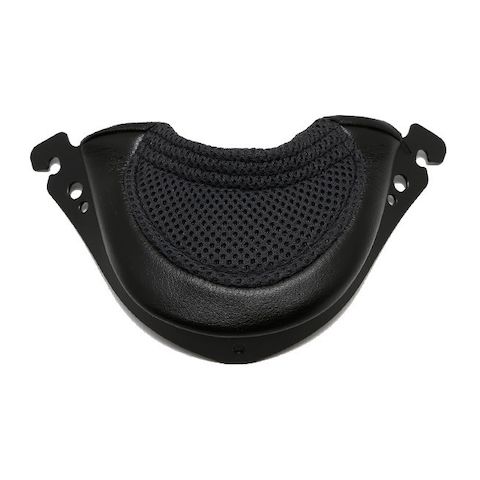Shoei GT Air Helmet
Filters
- Shop By
- Store Pickup
- Helmet Family
- Shoei GT Air 3 Helmets(3)
- Shoei GT Air Helmets(11)
- Shoei GT Air II Helmets(6)
- Shoei Hornet X2 Helmets(2)
- Shoei J-Cruise 2 Helmets(2)
- Shoei J-Cruise 3 Helmet(1)
- Shoei J-Cruise Helmets(2)
- Shoei Neotec 2 Helmets(3)
- Shoei Neotec 3 Helmets(1)
- Shoei Neotec Helmets(7)
- Shoei Qwest Helmets(3)
- Shoei RF-SR Helmets(2)
- Shoei RF1100 Helmets(3)
- Shoei RF1200 Helmets(3)
- Shoei RF1400 Helmets(1)
- Shoei X-12 Helmets(2)
- Shoei X-14 Helmets(2)
- Shoei X-15 Helmets(1)
- Color
- Price Range
- Discount Range
- Customer Rating
Read More about the Shoei GT-Air Helmet...
Welcome to our detailed breakdown of the brand-new Shoei GT Air Helmet, available at Revzilla.com.
So at 1000 feet, the Shoei GT Air Helmet is brand-new for 2013. The next iteration of what I'm really calling the best of what's available from Shoei. In the past, we've seen the staple helmet for a touring rider, for a three-quarter position, for a sport bike rider out in the track, be the RF1100.
What we've done here in the GT Air from Shoei is now you have the ability to take it multi-season. To have some of the more full-featured options that we've seen on the Neotech, we've seen on the Quest. We've seen them take leaps forward in the performance from the ventilation, aerodynamic, and really sun-blocking standpoint, into a new chassis that, in my opinion, looks very, very aggressive.
So I would love to hear your gut reaction at first glance to the GT Air. Leave it in the comments on this video. Remember, subscribe to us at Revzilla TV. Stay up to date with the latest gear reviews we're constantly rolling out.
Quick note on fitment and size. So I found myself to be a medium in other Shoeis. I'm a medium in this one. No discrepancies here.
From a shape standpoint, I find it to be a neutral or intermediate oval. So that's going to fit most people. Slightly longer front to back, but it's not extreme, and it's not round, either. So you might have . . . most people would have an easy time.
And I'll tell you, even around the temples, the way the cheek pads are done, they have cutouts for glasses, so that allows you to have a little more room to play if you have a little bit of a wider face, as well. Remember, you can always swap out those cheek pads.
We weighed this bad boy as well, and this is a size large, and we weighed it in at 3 pounds 11 ounces. So it's coming in that mid-threes range. Not terribly heavy. Again, DOT in its rating. It's not going to be Snell. But, again, rock solid. And when I get into some of the features, you're going to realize they crammed a lot into the Shoei GT Air in a pretty lightweight chassis.
So keep that in mind. And if you're scared about the fitment, don't fret if you're going to buy it online from us. We ship for free, exchange for free, no restock fee if you need to send it back to us. So don't worry about it.
So let's rewind all the way back to the highest level with the GT Air, and let's start at what's brand-new on this helmet and kind of build off that when we go through some of the features. And remember, I'm looking at a light silver. There are also graphics involved, as well.
Let's start with what I think is the most key component here on the GT Air: the internal sun visor. And it's the same internal sun visor that we saw on the Neotech. They've really come at it with a new spin on the internal sun visor in the industry. It's very, very smooth. It's called the QSV1 sun visor, same as on the Neotech.
It's cable operated on the left side. And they put the operator up here. It doesn't click. It doesn't stick. It's just nice, and it works really well. Drops right down with that optically correct, fog-free shield that's going to be smoking integrated. But they've done it in a way that's easy to find with a glove, and it's not going to get in the way of your Bluetooth communicator.
There are a lot of helmets out there that have it down here along the jawline. By moving it up a little bit, you're now out of harm's way. And this helmet's really well-optimized to put an after-market communicator in. So keep that in mind.
So you see that face shield come down? We saw it first on the Neotech. It works really well. Now we have it on the GT Air, and you're also going to see it on the J Cruise going into 2013. Check that video out. That's their three-quarter helmet.
Now, we look at the way that sun visor's done. And again, we saw this. And it kind of adds to that aerodynamic feel and shape here on the GT Air. Look at the way this brow goes. That hump here, which actually leads to these cutaways, allows Shoei to have the visor, the EPS, and the outer shell all sandwiched together without giving up any of the safety features, any of the thickness.
You have your aim shell, which is fiberglass, carbon fiber, and organic resins. And you're not thinning it to have that visor, but you're also not thinning the GPS, which is the shock absorbing element inside the helmet that keeps your head safe in the event of a crash.
So what they've done, you saw this band on the Neotech, you have a bulge slightly, and then I really like, on the GT Air, how they have this sweeping effect as it goes into the aerodynamics into the back of the shield. And again, you're getting that DOT-rated shield, and it's using some of the higher-end components with Shoei to construct this shield. The shell.
Remember, the shell's the energy management system. You introduce a shock, it's meant to send that shock all the way throughout the rest of the sphere and keep it on the sphere, lengthen the impact, save your brain.
Now, if we move back down to your visor system, you're also looking at the CNS1 system from Shoei. Love what they've done here. So it's their new wider and taller visor we saw on the Neotech. It's also pin lock ready out of the box.
But the beauty of the GT Air is that they're including your pin lock lens. So now it's coming with it. It's not fog-free coated because you don't need fog-free coating. Putting the pin lock in, using the laws of physics to have a fog-free mechanism that never wears off.
You also have your chin vent that now, instead of venting to the face, it actually vents to the shield, so it even dramatically increases the performance of the pin lock lens. Keep that in mind.
Nice, strong detents. And again, we're seeing a new feature from Shoei for the first time. It's a double-walled gasket construction. You see it all the way around the eye port. We've seen single-walled. We saw it on the Neotech. Now, in the J Cruise and the GT Air, we have a double wall, which, again, gives you a better seal. Better seal when it sucks it in against Mother Nature. If you're hitting the rain, an even better chance of keeping the rain out.
And I talked about the strong detents. But come in here really tightly and you're going to notice on the side pod, they call it self-adjusting, I call it spring-loaded. And what happens as you ratchet up and down, when it gets to the bottom detents, it sucks it in, and it's going to create that even better seal.
We've also seen Shoei change the way they've done their locking mechanism. The old locking mechanism, Atsby, would create a little bit of a whistle. And you're going to hear me talk about noise in a second here.
But what they've done to add to the quiet of this helmet, change the mechanism. It's really in line with what we see on the Neotech. And there's even a city position which cracks it, and again, gives you even more air ventilation to keep the fogging down here on our new style shield.
So, again, not needing to buy a dark smoke or a light smoke here unless you really want it, because you have the internal sun visor.
So let's talk about aerodynamics. Aerodynamics have been improved. We went out and we rode in this helmet. No issues at speed. No issues in the crouch. No issues with head checking. We did notice that it was more quiet.
They've also -- and when I get to the guts, you'll see them, when I pull them out -- they've changed the way the internal guts feel. It's not what I'm going to call a race fit. A race fit's that really, really snug cut that's hard to get on and off. But it is all-encompassing. It cuts down on the noise. The way they've configured it cuts down on the noise. The aerodynamic profile cuts down on the noise.
You still have good down force with the way the air flow's going to come over the top. You have the integrated spoiler. And I think I really love how this band, this ride for the integrated sun visor, allows for these cutaways that, for lack of a better term, just look really, really gnarly. It's a nice, sweeping look.
I saw this helmet a while ago. I found some leaked pictures on the internet about it. And I said, "Wow, that's going to be a shocker." And for those guys out there that want a more sporty helmet, but love the fact that they can get some of the multi-season, longer-distance touring functionality baked in, it should be a home run.
So let's move on to the venting structure, which has been changed. It's going to be updated in its look and its style. You can see here, if I bring it along the top.
The nice part, the first thing, is they're calling it the shuttering. It's not two positions, on/off, anymore. Now it's three positions. So you have open full, you have midway open, and you have closed.
And if you look at it, it's a similar vent configuration that vents into the helmet, into 10 mm vent holes, as we would see on the Neotech. But now it has a more aggressive shape here on the GT Air. And if you come in tight, you can see the three snaps. Easy to find with a glove on. We made sure of it.
And it's the wintertime here at Revzilla in Philadelphia, so again, we went out with a bulky glove. We wanted to see how it felt.
Moving on to the back. Now you have a rear spoiler. It's a rear spoiler vent. And again, three settings: open and closed. So we're seeing that shuttering effect here break down into the helmet, and you're getting more usability.
If you see how it sweeps along the back, you can see the back profile as well, moving through the lid.
So if we think about the air coming into the helmet, you're going to get it in this big brow vent, and it's going to get sucked back right out your ventry in the back. And the cool part about it, when we rode in it, we kind of had the takeaway, "Wow, it feels like a mohawk of air." You have EPS channels inside the helmet. They're going to suck that air through, disperse it. You really feel the air along the top, right along -- if you were Mr. T -- where Mr. T would feel the air, as well.
And if we move it along to the front, remember, I said that chin vent, it's got a new restyle for 2013 on this helmet, on the GT Air. Vents to the shield. And one of the things you might not realize is your air comes in, it circulates. Your air might come up from the chin vent, come along the shield, and get sucked back along that mohawk. It's going to exit down here. There are actually two really small channels that come all the way down, and they're going to give you some ventilation even down at the base of your neck, which is a really nice touch.
So as we move into the guts of the GT Air, I'm going to take a quick spin back to quiet. You know, the aerodynamics of this helmet were something that they spent a lot of time focusing on, especially since they were changing the front ridge.
But what you're going to see when we dive in here, you're going to see really a full comfort liner surrounded by a multi-density EPS. And the multi-density, it's going to be reinforced in the occipital region in the back, as well as along the forehead, areas that are a little bit more prone to impact.
And you're going to see even the speaker pockets on the side, the way that this helmet is done is really to cut down on wind noise. So you cut down on wind noise by eliminating turbulence on the outside of the helmet, and you also cut down wind noise by creating a fully effected inner liner of the helmet that really gives you good coverage on the inside.
Before I start removing anything . . . and remember, you know . . . actually, I'm a liar. I'm going to remove it right now. You can see that we have our removable chin spoiler.
But if we look here, the only helmet, I think, that we've seen from Shoei do an emergency cheek pad removal system are their dirt helmet and the Neo- . . . I'm sorry, and the X12 helmet. Now we have it on the GT Air.
And you can see these red pulls. I actually really dig that they're easy to find. You'd pull them away and down, and your cheek pad pops right out. So it's now an emergency quick release cheek pad system set up for EMTs. And remember, you can always change the side of your cheek pads. But it's done so that if you're unconscious and on the ground, they can get this helmet off without moving your neck.
Again, really important, especially if they're going to throw you on the board. Don't mean to paint such a morbid picture, but in this sport, we take the safety factor really seriously.
Now, if we look at it, it's the premium Shoei liner. And that's a wicking liner that's anti-bacterial and that's going to hold up a long time. And that's around your face.
But you can also see it's a little bit more durable as you get up here closer to the temple. This would be the right side of my face. I did mention that this is cutaway on the inside, and also the density's a little different, so the stems of your eyeglasses should fit in no problem, and you're not going to have any issues. Even if you have a little bit more fuller cheekbones, you should be good to go.
Remember, you can always swap out the cheek pads.
Now, I'm going to pull out my other side. Might as well use my emergency quick cheek pad removal system. Remember, double D ring here in my construction, that are coated with the same internal guts on my chin strap.
And as I busted into the helmet here -- busted in. I'm sounding so technical today -- there's no vent on the back of this chin bar. Remember that.
One of the cool things you're going to see is a positively locking snap-in cover for the ear cutout. And this cutout is what are going to house the speakers if you use an after-market system. So if you look here on the internal piece of the helmet, you're going to see that speaker cutout. And when you're not using it, you put this foam-backed piece in it. And again, it's going to be another additional element that's going to cut down on wind noise to the helmet. I'm going to pull them both out so you can see them really quickly, here.
And if we move into our comfort liner now, I've got my neck roll out, comfort liner starts to come out. This is a new technology from Shoei. First time we're seeing it. I'm a fan of it. It's even nicer than the Neotech. This is the 3D Max Dry Liner.
So what you see is it's still 3D in its construction, using mesh, using cutaways. Again, you have these air slots so that you're getting the mohawk of air that runs through when it comes into the shell itself.
But one of the nice things that you do have is you have a new style. It's almost a beefier mesh. It has some nice density to it. Adds to the comfort factor. You see it again along the top, along that mohawk area. It's a 3D bubble design. We see that in a lot of jackets. The boys in Italy pioneered this long ago. It promotes air flow, it promotes wicking of sweat, it promotes evaporative cooling, and you get a better sense of the cooling and the sweat coming off of your head through these top pieces.
Now, on the side, they said it's a little bit rougher than this. But again, it's against your hair or against the top of your head. You're not going to really feel it. On the sides, you have your more plush material.
You notice the way that I pulled it out. I love that it's not snaps up here. I love that it's along the brow, and it's plastic. Because that allows you to not have any pressure points in the helmet that aren't part of the comfort liner, as well. And you can always switch the comfort liners.
You know, as you go up the size curve with the Shoei GT Air, you're actually seeing four EPS sizes. So again, they're tuning this helmet for the best possible fit with your head.
I'm going to bust it out here. Man, that seems to be my new term today. You're going to see the channels as we walk through the helmet. Ten millimeter vent holes. We have channels that go all the way back down the helmet. And you're going to see that venting all the way down towards the bottom.
So remember, you're looking for sports touring multi-season, a do-it-all helmet that's a little more aggressive-looking than something like a Quest, which would be straight out a touring helmet, or something like Neotech, which is flip-up. Not everybody else's cup of tea.
If you want to make less of an investment than the GT Air, the RF1100 is your tried and true staple. But again, no internal sun visor. Set up a little bit differently.
In the box, there's also a breath guard, the chin guard, that's going to come installed. And it also doesn't come in the box installed with the pin lock lens, but you throw it on and bang, you're anti-fog, you're good to go, especially for the winter months.






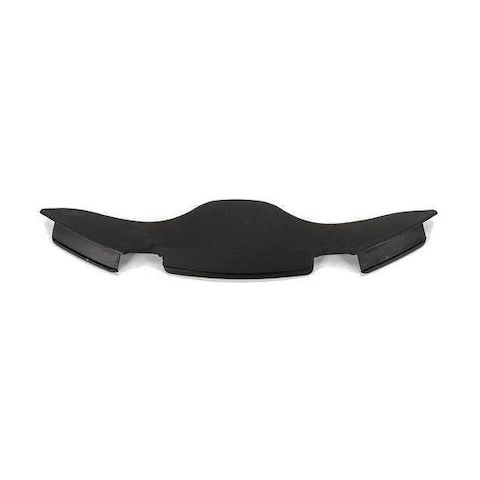
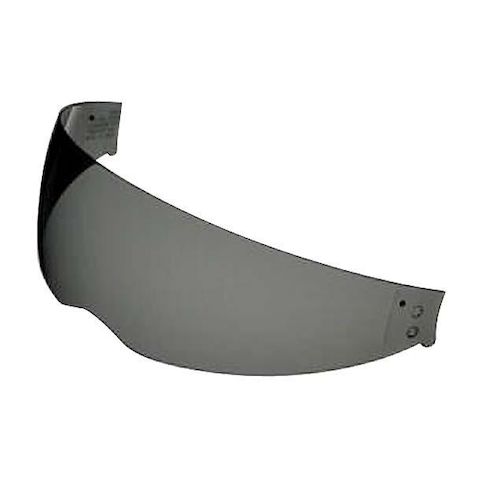
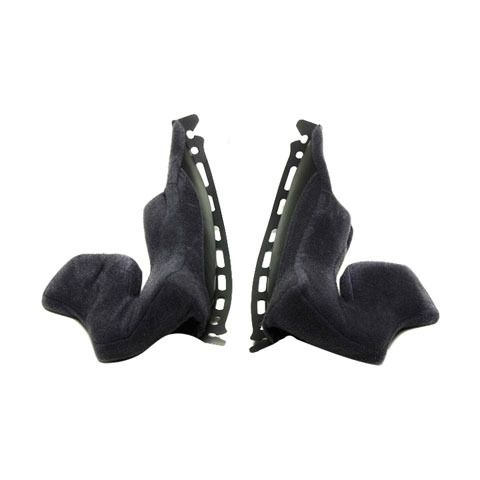

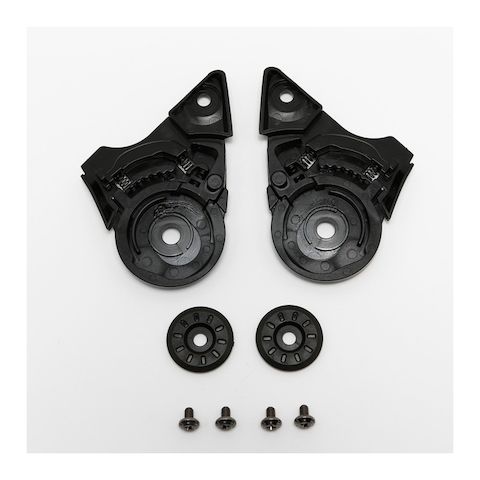
![Shoei CNS-1 Spectra Pinlock-Ready Face Shield Spectra Silver [Open Box]](https://www.revzilla.com/product_images/2518/6652/shoei_cns1_spectra_pinlock_ready_face_shield_spectra_silver_open_box_spectra_silver_480x480.jpg)

